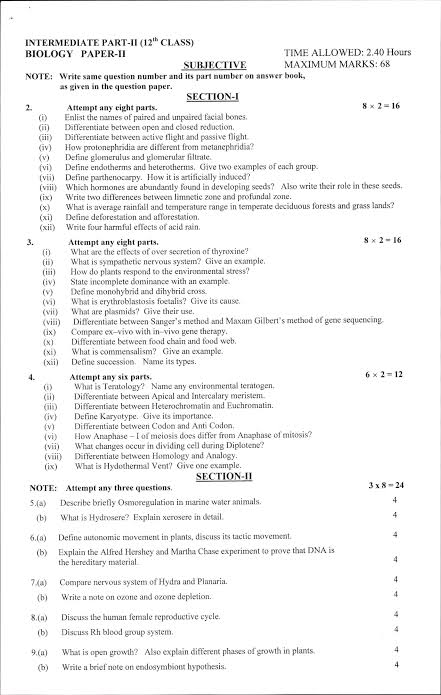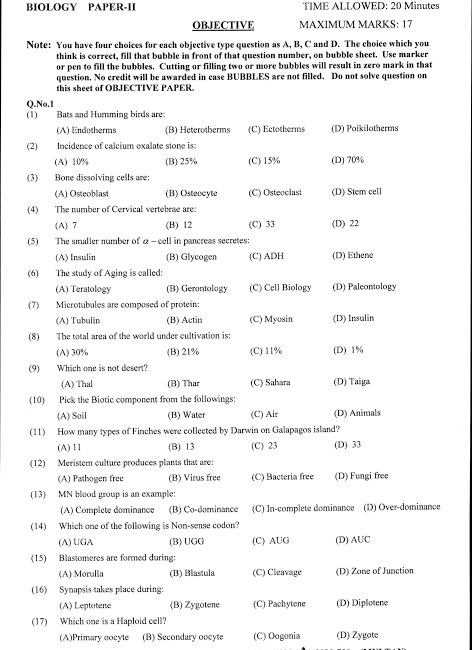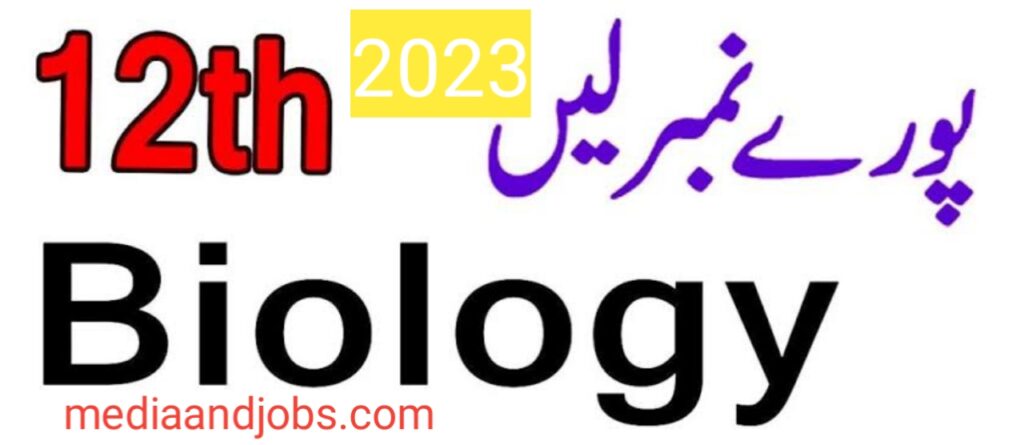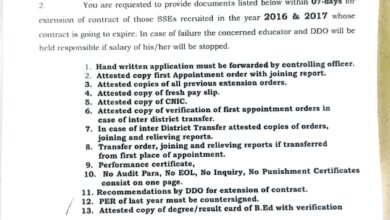Biology 2nd Year Punjab Boards Guess Paper 2023


Biology 2nd Year Punjab Boards Guess Paper 2023
2nd Year Biology Guess Paper Punjab Boards 2023
Table Of Contents
12th Biology Guess Paper 2023 Punjab Board. In this post we will share 2nd year biology guess paper. It is as per the syllabus designed by Punjab Boards.2nd Year Biology Guess Papers 2023. In this Biology Class 12 Paper for Exams 2023, we will share with you Multiple Choice Questions (MCQs), Most Important Short Questions and Important Long Questions. Class 12 Biology Guess Papers 2023.
2nd year biology important questions 2023 guess. To download the 2nd grade Biology Guess paper in pdf format, click on the button given below the preview window. You can also read this online biology estimation article below. Class 12 Biology Paper 2023 Punjab Board.
Biology paper for second year 2023. To download Year 2 Matching Scheme, Smart Syllabus and Guessing Papers, click on the below links to download them for free. 2nd year biology guess paper 2023 all Punjab Board download.
2nd Year Biology Guess Papers 2023 (Download 2nd Year Guess Papers App)

2nd year biology important questions 2023 guess 👇👇👇
Chapter Number 15 Important Short Questions
- Define homeostasis with examples.
- What are heat shock proteins?
- What are hypertonic and hypotonic environments and what changes occur in the cell in this environment?
- Distinguish between osmoconformers and osmoregulators.
- Distinguish between active flight and passive flight.
- Differentiate between shivering thermogenesis and non-shivering thermogenesis.
- Define endotherms, ectotherms, and heterotherms.
- Write four adaptations of xerophytes and hydrophytes and mesophytes.
- Distinguish filaments and sclereids.
- Differentiation of afferent and efferent arterioles.
- Define lithotripsy.
- What is hemodialysis? Give its importance.
- What is the foramen triosium? How are they formed?
- What is renal failure?
- Difference between ureotelic and urecotelic animals.
- Define anhydrobiosis with an example.
- What is hypoxaluria?
- Distinguish between photonasty and thermonasty.
- Define phototactic and chemotactic movements with examples.
Important long questions
- Discuss excretion in plants.
- Discuss kidney disorders with treatment.
- Discuss the role of the liver as an excretory organ.
- Discuss the thermoregulatory system in mammals.
Chapter 16 Important Short Questions
- Differentiate between bone and cartilage.
- Name the unpaired facial bones.
- Distinguish between apical, lateral and intercalary meristems.
- What is a blastoderm? Name its layers.
- What is hematoma formation?
- How is a callus formed?
- What is a synovial joint?
- State the composition of the exoskeleton in molluscs and arthropods.
- Distinguish between hyaline and fibrous cartilage.
- What is sciatica and its causes?
- Difference between effective and recovery strokes?
- What is non-disjunction? Give its effects.
- What is rickets? List its causes and treatment.
- Differentiation of tendons and ligaments.
- What are the internal factors that influence the growth process?
- What is secondary growth? Give its importance.
- What are brnachialis and branchioradialis?
Important long questions

- What is an endoskeleton? Describe bone and cartilage.
- Describe the importance of secondary growth in plants. Phases of plant growth.
- Give a detailed note on the sliding filament model.
- Explain the main parts of the axial skeleton and the appendicular skeleton.
- Explain the different types of joints.
Chapter 17 Important Short Questions
- What are effectors? List their types.
- List only the types of innate behavior.
- Differentiate between neurula and neurocoel.
- Define primary organizer and primary induction.
- Draw and label a sensory neuron.
- Define reflex arc.
- Differentiate between nerves and ganglia.
- What is a greeting impulse?
- What are the effects of nicotine on coordination?
- What is chlorosis?
- What is a hormone? Specify its type.
- Define habituation with an example.
- State the functions of the parathyroid and adrenal glands.
- What is Alzheimer’s disease?
Important long questions
- The nervous system of hydra is better developed than that of planaria. Discuss.
- Explain the structure and functions of the human brain using a diagram.
- Write a note on adrenal glands.
- How is a nerve impulse produced? Explain its mechanism with diagram?
Chapter 18 Important Short Questions
- Difference between sexual and asexual reproduction.
- Define parthenocarpy. Set an example.
- What is seed dormancy? Give its importance.
- What is photoperiodism? State its effects on plants.
- Define vernalization. Write its two advantages.
- Define tissue culture and cloning with examples.
- Distinguish between identical and fraternal twins.
- Distinguish oviparous and viviparous.
- Define menstrual cycle, estrus cycle and menopause.
- What is diploid parthenogenesis?
- What is the structure and function of the corpus luteum?
- Name sexually transmitted diseases with their relative causative agents.
- Define apormixis.
- Haploid and diploid parthenogenesis defined?
- What is ovulation?
Important long questions

- Explain the female menstrual cycle.
- Explain the male reproductive system of man.
- Compare asexual reproduction with sexual reproduction.
- Process the functions of the placenta during pregnancy.
Chapter 19 Important Short Questions
- Distinguish between growth and development.
- Distinguish between apical, lateral and intercalary meristems.
- Write three signs of aging.
- List two causes of abnormal development.
- What is a blastoderm? Name its layers.
- What are the internal factors influencing the growth process.
- What is discoidal fission.
- Differentiate between neurula and neurocoel.
- What is organogenesis?
- Define regeneration with an example.
- What is a meristem?
- What do you know about open growth?
- Distinction between the morulla and blastolua stages in chick development.
- What is the basic difference between a chicken and an amphibian embryo?
- Define correlation?
- Define hypoblast and epiblast?
- Describe the role of cytoplasm in development?
- What does differentiation mean?
Important long questions
- Write a note on the development of the chick.
- Describe the symptoms and causes of abnormal development.
- Explain the internal and external factors of growth.
- Explain the stages of growth in plants.
Chapter 20 Important Short Questions
- Define recombinant DNA. The role of phage lambda.
- What is an anticodon?
- What is a karyotype?
- Write the 3 main classes of RNA
- What is a mutation?
- Where does DNA replication begin on a DNA molecule?
- Define transformation process?
- Define chromosomes and nucleosomes?
- Define semiconservative replication?
- Explain sex-limited traits.
- What is a phosphodiester bond?
- Write the main component of DNA.
- Define point mutation and chromosomal aberration.
- What are Okazaki fragments? Enter their length.
- Difference between transcription and translation?
Important long questions
- Describe in detail DNA as hereditary material?
- Explain the work of Meselson and Stahi in the study of DNA.
- What are chromosomes? What do you know about their types.
- Explain Watson and Crick’s model of DNA.
Chapter 21 Important Short Questions
- What is non-disjunction? Do you give its effects?
- Define cell cycle. Give its phases.
- How cytokinesis takes place in animals and plants
- What is the mitotic apparatus? List its functions.
- Explain homologous and analogous organs.
- State the meaning of mitosis/meiosis.
- What is metastasis? Write its importance.
- Difference between apoptosis and necrosis.
- Write the symptoms and causes of Down syndrome?
- What is Turner syndrome? List its causes and characteristics.
- Define crossing.
- What does G0 phase mean?
- How does prophase of meiosis differ from mitosis?
- What is a chiasmata?
- What is interphase? Why is it called the resting phase?
Chapter 22 Important Short Questions
- Define euchromatin.
- What is cretinism?
- Describe gonorrhea.
- What is transformation?
- What is allele and gene and gene pool and gene frequency?
- What is above dominance and co-dominance?
- What is genetic drift? The genetic code. Fixed alleles.
- Name any four animals declared extinct in Pakistan.
- Define homozygous and heterozygous alleles.
- What is epistasis? What is Bombay Phenotype? Dominance?
- Difference between genotype and phenotype.
- What is totipotency and totipotent cell?
- What is a true breeding variety?
- What does the word MODY mean?
Important long questions
- Explain epistasis on the example of Bombay Phenotype.
- Define and explain Mendel’s law of segregation.
- What is incomplete dominance? Explain with an example.
- Explain the phenomenon of gene linkage in relation to linkage groups.
Chapter 23 Important Short Questions
- Define biotechnology. List its applications.
- Distinguish between molecular scissors and molecular vectors.
- Enter the two requirements for recombinant DNA production.
- Explain and give examples of ex vivo and in vivo gene therapies in humans.
- What are transgenic plants?
- List three possible ways to obtain the desired gene.
- List two goals of the Human Genome Project.
- What is a probe? State its use.
- Define genomic library.
Chapter 24 Important Short Questions
- How artificial selection differs from natural selection.
- State theory of special creation.
- Name any four animals declared extinct in Pakistan.
- Define Neo-Darwinism/Modern Synthesis?
- Define population genetics.
- What are hydrothermal vents? How do they support life?
- What are residual organs? Name some important stunted human organs.
- Define fossils? How do they provide evidence for evolution?
- What are threatened and endangered species? Give some examples.
- What is the Hardy-Weinberg theorem? Give its equation.
- Difference between homologous and analogous organs.
- State endosymbiont hypothesis.
Important long questions
- Discuss the evolution from prokaryotes to eukaryotes.
- Describe the evidence for evolution in various branches of biology, such as biogeography and the study of fossils.
- Explain Darwin’s theory of natural selection.
Chapter 25 Important Short Questions
- List the types of living organisms found in the limnetic zone. (his life) (2)
- Differentiate between climate and weather. (3)
- Define renewable and non-renewable resources. (5)
- Define ecosystem, biosphere, and biome.
- Using examples, distinguish between a population and a community.
- Difference between synecology and autecology.
- What is predation? Give its meaning.
- Define parasitism and commensalism.
- Define food chain and food web.
- Distinguish between a habitat and a niche.
- Distinguish between consumers and decomposers.
- Distinguish between hydrosere and xerosere.
- Distinguish between primary and secondary succession.
Important long questions
- Write a note on nitrogen cycle.
- Explain the biotic components of an ecosystem.
- Explain the stages of xeroser succession.
- Explain the flow of energy in a food chain.
Chapter 27 Important Short Questions
- Define deforestation and afforestation.
- What is the ozone layer? Provide its important function in the environment.
- Define water pollution and acid rain.
- Write a short note on non-renewable sources of energy.
- Explain the causes and consequences of ozone depletion.
- List the main causes/sources of water pollution.
- What is solid waste? Give its importance.
- Define the greenhouse effect. State its effects on the environment.
- Trees as environmental buffers.
Important long questions
- Describe deforestation and its effects.
- Write a note on: a) ozone depletion b) greenhouse effect
- Explain the meaning of forests/trees
- Briefly explain the causes and consequences of air pollution.
Now the guessing paper is over. I skipped chapter 26 because it’s not important. Moreover, long questions have been omitted from some chapters as no long question will arise from these chapters.
Join Us On :
Click Here To Get All Latest Government Jobs And Education News : https://mediaandjobs.com/
What’s app Group 1 (Jobsgoro And Updates)
https://chat.whatsapp.com/CVwROiD9kKSFwq6pnIdQxi
Click Here To Join Our Facebook Page To Get All Latest Government Jobs And Education News : https://www.facebook.com/profile.php?id=100085051735597&mibextid=ZbWKwL



